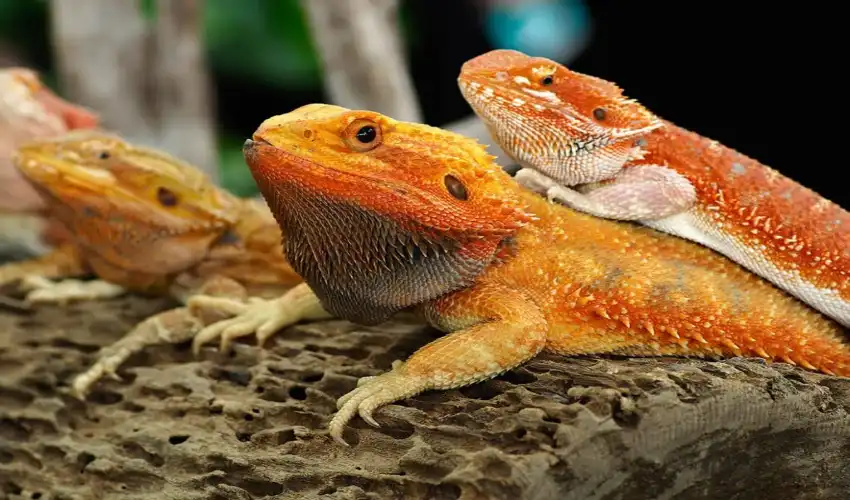The red bearded dragon, a vibrant and popular color morph of the well-known Pogona vitticeps, has fascinated reptile enthusiasts for years. Its striking color and unique characteristics make it a prized addition to the world of exotic pets. But when did this fiery reptile first make its appearance, and how has it become such a beloved part of the reptile community? Let’s dive into the history, development, and significance of the red bearded dragon.
- Understanding Bearded Dragons: A Brief Overview
Bearded dragons are a species native to the arid and semi-arid regions of Australia. The most common species kept as pets is Pogona vitticeps, also known as the central bearded dragon. These reptiles are known for their docile nature, ease of care, and unique behaviors, such as “waving” and “head-bobbing.” They come in a variety of colors and patterns, resulting from selective breeding practices.
- The Natural Origins of Bearded Dragons
The first records of bearded dragons in the wild date back to when European explorers encountered them during their expeditions through Australia in the 18th and 19th centuries. With their distinctive throat pouches and unique defensive behaviors, these reptiles caught the interest of biologists and herpetologists.
However, wild bearded dragons typically display earthy tones such as brown, tan, and light orange, which help them blend into their natural desert surroundings. The emergence of vibrant colors, such as the striking red morph, is a result of selective breeding rather than natural evolution.
- The Advent of Selective Breeding
Selective breeding is a practice that involves mating animals with specific desirable traits to produce offspring that carry those characteristics. This practice gained momentum in the reptile trade during the latter part of the 20th century when herpetoculture—keeping and breeding reptiles in captivity—became more mainstream.
The first significant push toward breeding colorful morphs of bearded dragons began in the 1990s. Breeders sought to create reptiles that deviated from the traditional earthy hues seen in wild specimens. Through careful pairing and genetic selection, different color morphs, including red, began to emerge.
- The First Red Bearded Dragons
The exact timeline of when the first true red bearded dragon for sale appeared can be traced back to the late 1990s and early 2000s. Dedicated breeders in Australia and the United States were instrumental in refining the traits that would lead to this stunning color variant.
Origins in Australia and the U.S.: While Australia was home to the initial discovery of bearded dragons, strict wildlife export laws meant that the emergence of exotic color morphs, such as red, gained traction in countries where breeding and genetic experimentation were allowed, particularly the U.S.
Key Breeders: Breeders like Sandfire Dragon Ranch, known for their pioneering work in developing new morphs, played an essential role in producing the first red variants. The meticulous selection process involved pairing dragons that exhibited reddish or orange hues over multiple generations to intensify the color.
- The Red Bearded Dragon: Characteristics and Appeal
The red bearded dragon is distinct from its more muted counterparts. The deep crimson or bright red coloration, combined with their unique scale patterns, sets them apart. This morph is not just prized for its color but also for its unique patterns and shades that range from a solid red to red mixed with orange or yellow highlights.
Health and Care: While breeding for color has been immensely successful, it is essential for breeders and pet owners to be aware of any potential health issues associated with color morphs. However, red bearded dragons generally maintain the same care requirements as other Pogona vitticeps variants, including a diet of insects, leafy greens, and appropriate UV light exposure.
- The Evolution and Popularity of Red Bearded Dragons
The popularity of red bearded dragons has continued to grow throughout the 21st century. Enthusiasts appreciate them for their vibrant appearance and friendly nature. Over the years, breeders have refined the red morph further, producing subcategories like blood reds, which are deeply saturated in color, and ruby reds that feature a brighter, jewel-like hue.
Community and Competitions: The reptile community hosts various shows and competitions where breeders showcase their unique morphs. The red bearded dragon often takes center stage in such events, highlighting the continuous efforts of breeders to perfect this captivating lizard.
- Conservation and Ethical Considerations
While selective breeding has led to the stunning variety of bearded dragons available today, it’s crucial to consider the ethical implications. Responsible breeding practices should prioritize the health and well-being of the reptiles to avoid inbreeding issues or the propagation of genetic conditions that could affect quality of life.
The Role of Education: For new owners, understanding the origins of their pet’s color morph and the importance of choosing reputable breeders helps ensure the ethical treatment of animals. The reptile community places a strong emphasis on educating buyers about responsible pet ownership.
Conclusion
The emergence of the red bearded dragon is a testament to the dedication and skill of breeders who have worked tirelessly to create unique and captivating pets. From their origins in the late 20th century to their continued development and refinement, red bearded dragons remain one of the most sought-after morphs in the reptile world. As they continue to captivate reptile enthusiasts with their bold colors and gentle demeanor, their history highlights both the creativity and responsibility that come with selective breeding.
Whether you’re a new owner or an experienced reptile aficionado, the red bearded dragon stands as a remarkable example of how nature and human curiosity intersect to create something truly extraordinary.
